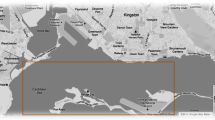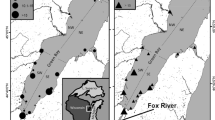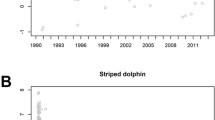Abstract
Whole-body elimination coefficients of polychlorinated biphenyls (PCBs) were determined in two Great Lakes invasive fish species, round goby (Neogobius melanostomus) and tubenose goby (Proterorhinus semilunaris). Elimination rates were determined for a set of model PCB congeners (n = 12 congeners) dosed to fish by intraperitoneal injection and allowed to depurate at a temperature of 21.4°C for 90 days. Eight PCBs (PCB 6, 21, 57, 62, 68, 89, 112 and 125) exhibited significant elimination by round goby and had corresponding half lives ranging from 13 to 39.8 days. For tubenose goby, four congeners (PCBs 21, 57, 62 and 68) exhibited significant elimination with half lives in the range from 18.8 to 48.8 days. Whole-body elimination rate coefficients were significantly higher for round gobies compared to tubenose goby. In both cases, PCB elimination rate coefficients were negatively related to chemical log KOW.


Similar content being viewed by others
References
Chu S, Hong CS (2004) Retention indexes for temperature-programmed gas chromatography of polychlorinated biphenyls. Anal Chem 76:5486–5497
Connolly JP, Pedersen CJ (1988) A thermodynamic-based evaluation of organic-chemical accumulation in aquatic organisms. Environ Sci Technol 22:99–103
Daley JM, Leadley TA, Drouillard KG (2009) Evidence for bioamplification of nine polychlorinated biphenyl (PCB) congeners in yellow perch (Perca flavascens) eggs during incubation. Chemosphere 75:1500–1505
Diggins TP, Kaur J, Chakraborti RK, DePinto JV (2002) Diet choice by the exotic round goby (Neogobius melanostomus) as influenced by prey motility and environmental complexity. J Great Lakes Res 28:411–420
Drouillard KG, Chan S, O’Rourke S, Haffner GD, Letcher RJ (2007) Elimination of 10 polybrominated diphenyl ether (PBDE) congeners and selected polychlorinated biphenyls (PCBs) from the freshwater mussel, Elliptio complanata. Chemosphere 69:362–370
Fisk AT, Norstrom RJ, Cymbalisty CD, Muir DCG (1998) Dietary accumulation and depuration of hydrophobic organochlorines: bioaccumulation parameters and their relationship with the octanol/water partition coefficient. Environ Toxicol Chem 17:851–961
Frame GM, Cochran JW, Bewadt SS (1996) Complete PCB congener distributions for 17 Aroclor mixtures determined by 3 HRGC systems optimized for comprehensive, quantitative, congener-specific analysis. J High Resolut Chromatogr 19:657–668
Gobas FAPC, MacLean LG (2003) Sediment-water distribution of organic contaminants in aquatic ecosystems: the role of organic carbon mineralization. Environ Sci Technol 37:735–741
Gobas FAPC, Zhang X, Wells R (1999) Gastrointestinal magnification—the mechanism of biomagnification and food-chain accumulation of organic-chemicals. Environ Sci Technol 27:2855–2863
Hansen BJ, Paya-Perez AB, Rahman M, Larsen BR (1999) QSARs for KOW and KOC of PCB congeners: a critical examination of data, assumptions and statistical approaches. Chemosphere 39:2209–2228
Hattula ML, Karlog O (1973) Absorption and elimination of polychlorinated biphenyls (PCB) in goldfish. Acta Pharmacol Toxicol 32:237–245
Hecky RE, Smith REH, Barton DR, Guildford SJ, Taylor WD, Charlton MN, Howell T (2004) The nearshore phosphorus shunt: a consequence of ecosystem engineering by dreissenids in the Laurentian Great Lakes. Can J Fish Aquat Sci 61:1285–1293
Johnson TB, Bunnell DB, Knight CT (2005) A potential new energy pathway in central Lake Erie: the round goby connection. J Great Lakes Res 31(S2):238–251
Kocovsky PM, Tallman JA, Jude DJ, Murphy DM, Brown JE, Stepien CA (2011) Expansion of tubenose gobies (Proterorhinus semilunaris) into Western Lake Erie and potential effects on native species. Biol Invasions 13:2775–2784
Lazar R, Edwards RC, Metcalfe CD, Metcalfe T, Gobas FAPC, Haffner GD (1992) A simple, novel method for the quantitative analysis of coplanar (non-ortho substituted) polychlorinated biphenyls in environmental samples. Chemosphere 25:493–504
Li J, Drouillard KG, Branfireun B, Haffner GD (2015) Comparison of the toxicokinetics and bioaccumulation potential of mercury and polychlorinated biphenyls in goldfish (Carassius auratus). Environ Sci Technol 49:11019–11027
Morrison HA, Whittle DM, Haffner GD (2000) The relative importance of species invasions and sediment disturbance in regulating chemical dynamics in western Lake Erie. Ecol Model 125:279–294
Ng CA, Berg MB, Jude DJ, Janssen J, Charlebois PM, Amaral LAN, Gray KA (2008) Chemical amplification in an invaded food web: seasonality and ontogeny in a high-biomass, low-diversity ecosystem. Environ Toxicol Chem 27:2186–2195
Niimi AJ, Oliver BG (1983) Biological half-lives of polychlorinated biphenyl (PCB) congeners in whole fish and muscle of rainbow trout (Salmo gairdneri). Can J Fish Aquat Sci 40:1388–1394
O’Neil JA, Johnson TB, Drouillard KG (2013) Validation of rapid assimilation of PCBs. Bull Environ Contam Toxicol 91:135–140
Paterson G, Drouillard KG, Haffner G (2007) PCB elimination by yellow perch (Perca flavescens) during an annual temperature cycle. Environ Sci Technol 41:824–829
Vanderploeg HA, Naleopa TF, Jude DJ, Mills EL, Holeck KT, Liebig JR, Grigorovich IA, Ojaveer H (2002) Dispersal and emerging ecological impacts of Ponto–Caspian species in the Laurentian Great Lakes. Can J Fish Aquat Sci 59:1209–1228
Acknowledgments
This research was supported by an NSERC Canadian Aquatic Invasive Species Network (CAISN) grant. The authors would like to thank T.Leadley for help with the experimental set-up and animal husbandry. We would also like to thank research technicians J.Robinet and S.n Grigorakis for help with sampling of field animals in the Detroit River.
Author information
Authors and Affiliations
Corresponding author
Rights and permissions
About this article
Cite this article
Sun, X., Johnson, T.B. & Drouillard, K.G. Determination of PCB Elimination Coefficients in Round Goby and Tubenose Goby. Bull Environ Contam Toxicol 97, 346–352 (2016). https://doi.org/10.1007/s00128-016-1876-6
Received:
Accepted:
Published:
Issue Date:
DOI: https://doi.org/10.1007/s00128-016-1876-6




